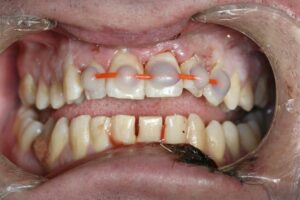What is it?
Dental splints are orthodontic appliances used to stabilize, support, or realign teeth, jaws, or temporomandibular joints (TMJ). They are commonly prescribed by dentists or orthodontists to address various dental issues and provide therapeutic benefits. Dental splints come in different types and designs, each serving specific purposes and tailored to individual patient needs. Here’s an overview of dental splints and their key aspects:
- Indications for Dental Splints:
- Dental splints may be recommended for patients with the following conditions:
- Teeth grinding or clenching (bruxism), which can lead to tooth wear, jaw pain, and muscle tension.
- Temporomandibular joint (TMJ) disorders, such as TMJ pain, clicking, popping, or dysfunction.
- Tooth mobility or trauma resulting from accidents, injuries, or periodontal disease.
- Orthodontic problems, including tooth misalignment, malocclusion, or bite irregularities.
- Postoperative stabilization following dental procedures, such as tooth extraction, dental implant placement, or orthognathic surgery.
- Types of Dental Splints:
- There are several types of dental splints available, each serving specific therapeutic purposes:
- Nightguards: Nightguards, also known as occlusal splints or bite guards, are custom-made appliances worn during sleep to protect the teeth and jaws from the harmful effects of bruxism. They help alleviate symptoms of teeth grinding, reduce tooth wear, and relieve jaw muscle tension.
- TMJ Splints: TMJ splints, also called occlusal appliances or bite plates, are designed to reposition the jaw and provide support for patients with TMJ disorders. They help reduce joint pain, improve jaw function, and promote relaxation of the jaw muscles by stabilizing the bite and reducing excessive force on the TMJ.
- Orthodontic Splints: Orthodontic splints, such as space maintainers, retainers, or aligners, are used to support orthodontic treatment and facilitate tooth movement. They help maintain proper tooth alignment, prevent relapse, and optimize treatment outcomes in patients undergoing orthodontic therapy.
- Periodontal Splints: Periodontal splints, also known as fixed or removable bridges, are used to stabilize mobile teeth and prevent further tooth movement in patients with periodontal disease or tooth mobility. They provide support for weakened or compromised teeth by splinting them to adjacent healthy teeth or dental implants.
- Fabrication and Customization:
- Dental splints are custom-made appliances fabricated to fit the individual patient’s mouth anatomy and address specific dental concerns. The fabrication process typically involves taking impressions or digital scans of the patient’s teeth and jaws, which are used to create a precise replica of the oral structures. The splint is then fabricated using biocompatible materials, such as acrylic resin or thermoplastic polymers, and adjusted to achieve proper fit, comfort, and functionality.
- Treatment Planning and Monitoring:
- Before prescribing a dental splint, the dentist or orthodontist will conduct a comprehensive evaluation of the patient’s dental and medical history, perform a clinical examination, and may request additional diagnostic tests, such as X-rays or jaw movement analysis. Based on the findings, a personalized treatment plan is developed to address the patient’s specific needs and goals.
- Throughout the treatment process, patients are closely monitored by their dental care provider to assess treatment progress, evaluate the effectiveness of the splint therapy, and make any necessary adjustments or modifications to ensure optimal outcomes.
- Patient Education and Maintenance:
- Patients receiving dental splints are provided with instructions on proper wear and care of the appliance, including hygiene practices, maintenance routines, and potential side effects or complications to watch for. It’s important for patients to follow these guidelines and attend regular follow-up appointments to monitor their oral health and address any concerns that may arise during treatment.
- Long-Term Benefits and Outcomes:
- Dental splints can provide significant therapeutic benefits and improve the overall oral health and quality of life for patients with various dental conditions. By stabilizing the teeth, jaws, or TMJ, splints help alleviate pain, reduce tooth wear, enhance oral function, and promote long-term dental stability. With proper treatment and maintenance, patients can experience lasting relief from their symptoms and enjoy a healthier, more comfortable smile.
In summary, dental splints are valuable therapeutic appliances used in dentistry to address a wide range of dental issues, from bruxism and TMJ disorders to orthodontic problems and periodontal disease. By providing support, stabilization, and realignment of the teeth and jaws, splints help improve oral health, alleviate symptoms, and enhance the overall well-being of patients.

